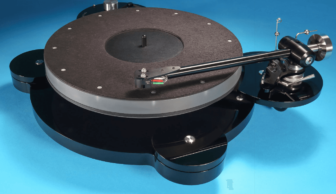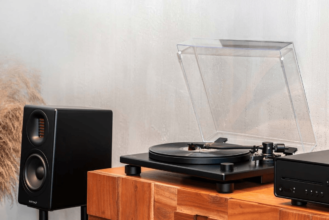Pro-Ject Audio Systems X2 Review
The new big brother to the successful X1 adds a host of improvements in order to justify its £ price premium. But at this new price, it can be tougher to succeed. Read our Pro-Ject Audio Systems X2 Review.
Review: David Price
Lab: Paul Miller.
Belt-driven turntable system with manual speed control
Made by: Pro-Ject Audio Systems, Austria
Supplied by: Henley Audio Ltd, UK
Telephone: 01235 511166
Web: www.project-audio.com; www.henleyaudio.co.uk
Sometimes a product comes along that really hits the spot, delivering a combination of performance and value that shakes up the hi-fi world. Audiophiles of more mature years will be able to reel off a number of these, whether it be the NAD 3020 amplifier of the late ’70s [HFN Nov ’ 12], the mid ’80s Wharfedale Diamond loudspeakers [HFN May ’18], or the Marantz CD63 MkII KI Signature CD player from 1996.
Contents
Pro-Ject Audio Systems has, of course, produced several game-changers over its long lifetime too, starting with its very first turntable, the Pro-Ject 1 from 1991. This was a minimalist, bare-bones budget design that sounded far better than it had a right to, given that it cost less than what most people spend on loudspeaker cables.
Earlier this year, the company repeated the trick with its EISA Award-winning X1 turntable – a 21st century version of the Pro-Ject 1, reimagined with a raft of improvements yet at £ costing little more than the original in real terms. Now we have its bigger brother, the X2, its purpose being again to redefine the turntable market, only this time the sector above that occupied by the X1.
HEAVY AFFAIR
However, the X2 has a real fight on its hands, and not only because of the sheer value offered by the more affordable X1. The real threat to the deck’s success is that competition is so much stiffer when you approach the £ mark.
While Pro-Ject adopted a ‘less is more’ approach when developing the X1, the philosophy behind the X2 might well be described as ‘more for less than you might expect’. This means you get a beefier, chunkier turntable than the X1.
The 460x150x340mm (whd) plinth is – if you’ll pardon the expression – the base of all the improvements. It’s a heavier MDF
RIGHT: With the 2kg acrylic platter removed the sub-platter, belt and AC motor are all revealed beneath. Arm counterweight underreads by 10% (so 1g dialled-up is 1.1g in practice)
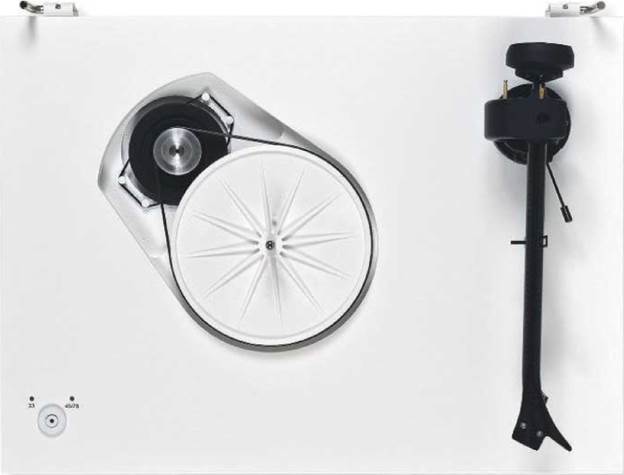
affair sporting an impressive eight layers of paint, polished by hand to give a finish that belies the deck’s price. The paintwork comes in a choice of three finishes – gloss black, satin black or satin white – with the deck also available in an eye-catching walnut wood veneer as a fourth option.
The motor has been retained from the X1, but gains a new suspension system which sees it suspended on a free-floating TPE belt – an arrangement Pro-Ject says decouples it from the plinth more effectively. As with the X1, the plinth also houses a DC/AC generator board to supply juice to the motor, and also sports three alloy/polymer sandwich isolating feet, which this time are chunkier. The supplied one-piece tonearm tube is again of carbon and aluminium sandwich construction but at 9in is longer than the 8.6in arm found on the X1. It’s wider in diameter too and also claimed to offer greater resonance
‘The drum rolls with their crazy pans had real presence here’
control. A TPE-damped counterweight is fitted, again to reduce vibrations, while an alloy tonearm base is used instead of a plastic flange, said to make for stiffer mounting to the plinth.
SILVER SAVINGS
The arm includes both azimuth and VTA adjustment and the ability to dial-up the tracking force. Our sample came pre-fitted with an (Ortofon) Pick it 2M-Silver MM cartridge [see PM’s boxout, p49] though you can buy the deck without this for £ less. Given that the cartridge costs £ separately, you make a healthy saving buying it as part of the package, which also includes Pro-Ject’s shielded, low-capacitance Connect it E interconnects with RCA terminations.
As with the Pro-Ject X1, electronic speed control is fitted with the choice of 33.3, 45 and 78rpm. Meanwhile, the 30mm-thick main platter is made of acrylic and weighs 2kg. This rests on a sub-platter, which in turn sits atop a stainless steel main bearing equipped with bronze bushings.
Although the new X2 benefits from a good number improvements, thankfully this hasn’t made it any more complex to set up, which was another key aspect of the XI’s appeal. As before, remove the turntable from its box, place it on a level surface, then begin assembly. This includes fitting the drive belt and platter, the counterweight, balancing the arm, then fitting the ‘thread and weight’ bias adjuster before attaching the tonearm cables.
The cartridge needs to be tracking at 1.8g if you’re using the Pick it 2M-Silver MM cartridge, as we did for this review. Effective tonearm mass is said to be 13.5g – a moderate value that also renders it compatible with a range of moving-coils.
As with the X1, Pro-Ject supplies a choice of round-section or square-section/ flat drive belts, and it’s up to the user to decide which of these they prefer. Our measurements clearly show that the square-section belt was superior [see PM’s Lab Report], and this was borne out by what we heard. Subjectively, the round-section belt served up a sound that was less stable, resulting in a slightly looser presentation that was particularly noticeable in the bass. Naturally, the flat belt was used for my listening!
SONOROUS SOUNDS
There’s a lot that’s right about the sound of the Pro-Ject X2 – especially if you’re comparing it to its more affordable sibling. But it’s also a strong performer relative to what else is on the market at the price.
It sounds open and detailed, has a wide soundstage and is on the neutral side. There’s no big bass overhang to give music a fatter, fruitier sound, yet neither is the presentation bright and forward.
I enjoyed its balanced take on ‘Visions Of Angels’ by Genesis [Trespass; Charisma
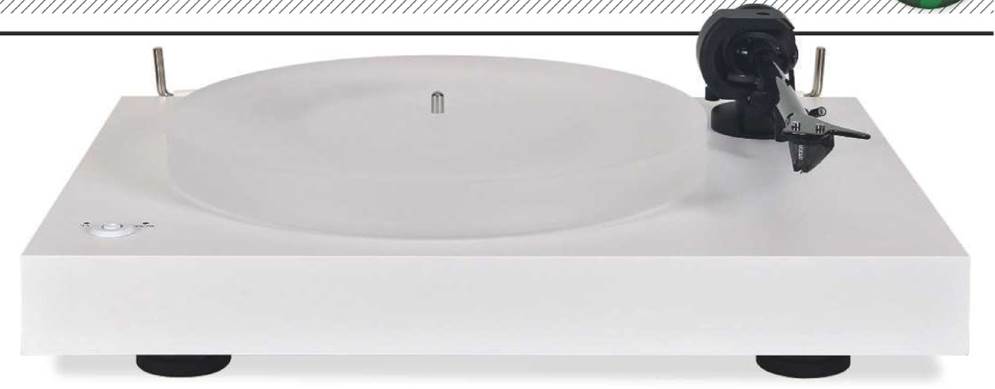
ABOVE: A neat and compact, modern-looking turntable, the X2 is arguably most attractive in its satin white finish. Here the supplied black felt platter mat is removed to show the platter itself
CAS 1020]. This ’70s prog rock track can sound overly bright on some similarly- priced decks, with Peter Gabriel’s vocals having an unwanted edge and the electric organ an inappropriate zing. Not so here, the X2 sounding perfectly at home and able to deliver the hi-hats with a perfect lustre. The piano was satisfyingly accurate too, having nicely sonorous harmonics and fine pitch stability, while the bass guitar enjoyed a fair degree of thump – even if this wasn’t the most muscular I’ve heard.
And it’s the low-end that gives the first clues that when it comes to dynamics, the deck can be a bit of a mixed bag. Put on a modern pressing such as Fourth Kind’s ‘Time Flies By’ [Fourth Kind; Omniverse OMNILP05 and while it’ s never less than an engaging experience, there are times you’re left wanting a slightly punchier presentation. This track has a superbly recorded drum kit, over which multiple layers of keyboards and synthesisers play. The X2 separates each instrument with ease, yet it doesn’t quite capture the full power of the drums or the reverb tails of the ride cymbals.
FUN FACTOR
The Pro-Ject X2 also showed its limitations when it came to spatiality. Although now 45 years old, Celeste’s ‘Principe di Giorno’ [Celeste Principe di un Giorno; AMS LP15] is a wonderfully expansive-sounding album, and while instruments were well located within a wide soundstage – the Mellotron and violin having an almost physical presence, with expressive flute –
VINYL ALLIANCE
The relationship between Pro-Ject and Danish pick-up brand, Ortofon, is long-established but their recent trajectories might not have been so closely aligned without the intervention of their mutual UK distributor,
Henley Audio. Laurence Armstrong, MD of Henley Audio (then Ortofon UK), saw the potential of both brands through the 1990s and became the ‘unofficial’ contact between the two companies – sometimes selling his own stock directly to the Pro-Ject factory. This facility, combined with Pro-Ject founder Heinz Lichtenegger’s passion for plug-and-play solutions, swiftly grew into a significant business. Despite the fall of the Wall some years before, ‘creative’ means were still often required to get volumes of cartridge stock through to the turntable factory in the Czech Republic! But as the enduring effects of the iron curtain declined, trade became easier, and in 2004 Ortofon was acquired by Christen H Nielsen (ex-Jamo) and his business partners. Today the open cooperation between Ortofon and Pro-Ject is inescapable with almost every Pro-Ject turntable being available with the option of a pre-installed Ortofon cartridge. PM
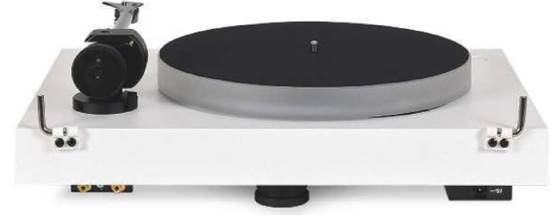
ABOVE: Stereo RCA sockets are mounted under the left of the plinth, PSU input to the right. Three machined feet screw into place for levelling and vibration control
playing towards the front of the mix – depth perspective couldn’t rival that achieved by a higher-end turntable. Nevertheless, given the price of the X2 it would be wrong to be too harsh on the fact that the soundstage was slightly curtailed front to back. Rather, the X2’s appeal is based around its general enthusiasm and the obvious fun it has when making music.
The Genesis track showcased this, as well as the deck’s sense of get-up and go. In my experience the company’s turntables all share this trait to one degree or another, but here it was in abundance. There’s a lot going on in ‘Visions Of Angels’, and on some decks it can merely plod along. On the X2 the track sounded lively and animated, the frenetic drum rolls with their crazy pans from left to right in the mix being carried with real presence.
READY TO ROUSE
A switch to Chic’s ‘I Want Your Love’ [C’est Chic; Atlantic SD 19209], only confirmed this. A rousing disco number released just a few years after Trespass, the song is based around Nile Rogers’ pummelling basslines with super tight rhythm guitar-work overlaid. The X2 pieced all this together very well, along with the sparse percussion, piano and string embellishments. The music had a real sense of motion while the deck captured all the tension and release being generated by the string arrangements.
It’s an able information retriever too. Great song though it may be, Crosby, Stills and Nash’s ‘Wooden Ships’ [Crosby, Stills And Nash; Atlantic SD 8229] is not up there in the pantheon of superlative audiophile recordings. Despite this, the X2 was able to fish deep into the mix to communicate a surprisingly large amount of what was going on. It focused on the lead vocals and that sublime solo electric guitar playing, showing off the beautiful harmonies of the former and gravelly texture of the latter. Yet there was plenty more to hear, including the surprisingly crisp rhythm guitar work set towards the back of the mix, and the electric organ alongside it. And although the listener could hear right into the proceedings to enjoy quite remarkable levels of insight, the deck never sounded overly analytical, as some rivals can.
The deck’s fine speed stability and overall control make for a stimulating listen. Yes, there can be the feeling on some recordings that things could do with a little more punch, but the X2 is entering the territory of turntables all able to turn in quite a captivating performance and all are strong in some areas rather than others. In short, the Pro-Ject X2 has much to offer considering its keen pricing. Indeed it’s proof that you can get a lot of sound per pound from turntables these days, even from almost ‘plug and play’ designs such as this.
VERDICT
LAB REPORT
PRO-JECT AUDIO SYSTEMS X2
Pro-Ject’s X2 turntable/arm/MM combination shares the same PSU, motor and bearing as its more affordable X1 cousin [HFN Aug ’19], but the platter, arm and plinth have all been beefed- up, contributing an added 3kg to the X2’s weight. The deck is supplied with both a round-section and flat rubber belt – so while bloggers can occupy web pages debating which sounds best, I’ll urge HFN readers to leave the round-section belt in the box and use the flat version instead. The former causes a measurable deterioration in W&F and rumble and a speed error of +1.3% that some listeners might mistake for extra ‘pace’!
Measured directly through the stainless steel/brass/Teflon bearing, the heavier 2kg acrylic platter causes a slight increase in rumble from -66.7dB (X1, DIN-B wtd) to -65.5dB here, a figure that improves to -66.6dB (through groove) with the felt mat in place and -67.0dB with the mat removed. Start-up time is necessarily slightly slower too at 4-5secs while absolute speed is super-accurate with the flat belt at +0.02%. Wow is improved over the X1, which was already very good, down to 0.02% and witnessed by the sharpness of the test signal [Graph 1, below]. However, the 83Hz (motor/rubber band suspension?) resonance is much more obvious in the X2 (just -50dB re. 1kHz/5cm/sec), the ±83Hz sidebands contributing to the higher 0.07% flutter.
The 9in X2 tonearm is based on that fitted to Pro-Ject’s ‘The Classic’ deck [HFN Aug ’ 16], the alloy/carbon tube construction and bearing yoke are identical, as is the 13.5g effective mass. The main tube mode is diffuse at 145Hz, while the harmonic/ twisting mode at 280Hz and cluster of resonances at 510Hz and 645-860Hz are of higher Q, but quickly damped. PM
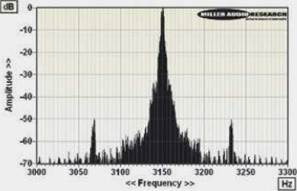
ABOVE: Wow and flutter re. 3150Hz tone at 5cm/sec (plotted ±150Hz, 5Hz per minor division)
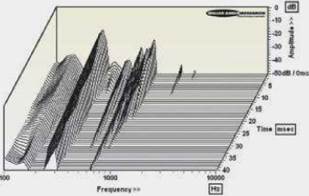
ABOVE: Cumulative tonearm resonant decay spectrum, illustrating various bearing, pillar and ‘tube’ vibration modes spanning 100Hz-10kHz over 40msec
SPECIFICATIONS | |
| Turntable speed error at 33.33rpm | 33.34rpm (+0.02%) |
| Time to audible stabilisation | 4sec |
| Peak Wow/Flutter (Peak wtd) | 0.02% / 0.07% |
| Rumble (silent groove, DIN B wtd) | -66.6dB (-67.0dB) |
| Rumble (through bearing, DIN B wtd) | -65.5dB |
| Hum & Noise (unwtd, rel. to 5cm/sec) | -52.5dB |
| Power Consumption | 5W (1W standby) |
| Dimensions (WHD, with lid) / Weight | 460x150x340mm / 10kg |
Pro-Ject Audio Systems X2 Turntable Explained! With Heinz Lichtenegger
Join Pro-ject Audio Systems CEO and Founder Heinz Lichtenegger as he discusses the key points and gives a general overview of the Pro-Ject Audio Systems ...



